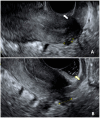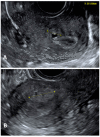Deep Infiltrating Endometriosis in Adolescence: Early Diagnosis and Possible Prevention of Disease Progression
- PMID: 38256683
- PMCID: PMC10816815
- DOI: 10.3390/jcm13020550
Deep Infiltrating Endometriosis in Adolescence: Early Diagnosis and Possible Prevention of Disease Progression
Abstract
Endometriosis has a prevalence of 10% worldwide in premenopausal women. Probably, endometriosis begins early in the life of young girls, and it is commonly diagnosed later in life. The prevalence of deep infiltrating endometriosis (DIE) in adolescence is currently unknown due to diagnostic limits and underestimation of clinical symptoms. Dysmenorrhea is a common symptom in adolescents affected by DIE, often accompanied by dyspareunia and chronic acyclic pelvic pain. Ultrasonography-either performed transabdominal, transvaginal or transrectal-should be considered the first-line imaging technique despite the potential for missed diagnosis due to early-stage disease. Magnetic resonance imaging should be preferred in the case of virgo patients or when ultrasonographic exam is not accepted. Diagnostic laparoscopy is deemed acceptable in the case of suspected DIE not responding to conventional hormonal therapy. An early medical and/or surgical treatment may reduce disease progression with an immediate improvement in quality of life and fertility, but at the same time, painful symptoms may persist or even recur due to the surgery itself. The aim of this narrative review is to report the prevalence of DIE in adolescents, describe the pathogenetic theories and discuss the management in adolescent women, including the challenging road to diagnosis and the treatment alternatives.
Keywords: adolescence; deep infiltrating endometriosis; diagnosis; pelvic pain; treatment.
Conflict of interest statement
The authors declare that they have no conflict of interest.
Figures



References
Publication types
LinkOut - more resources
Full Text Sources

